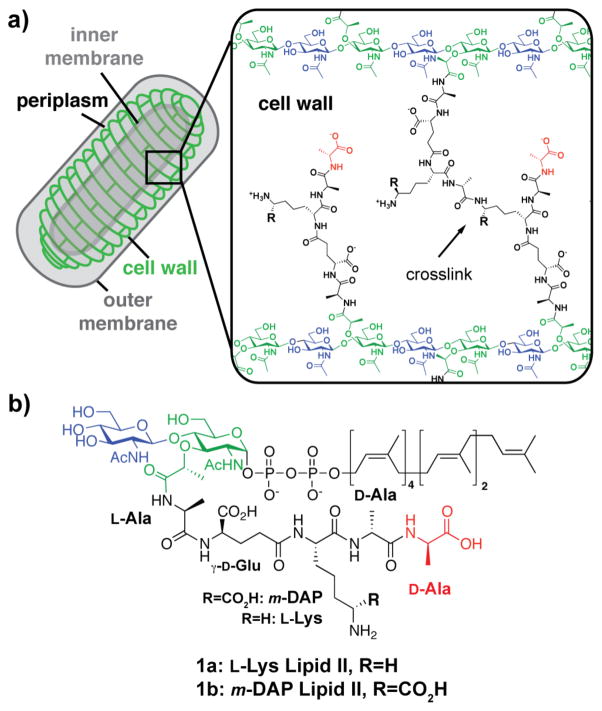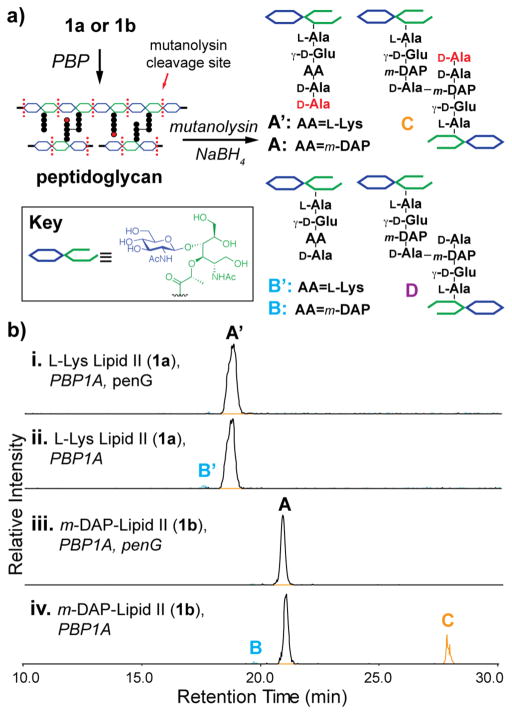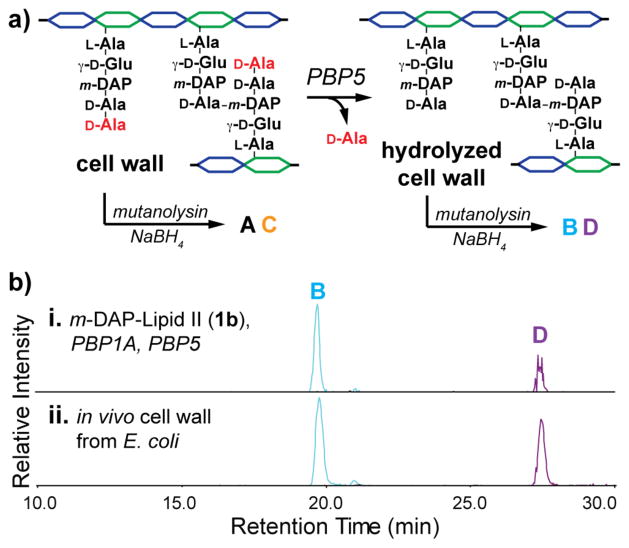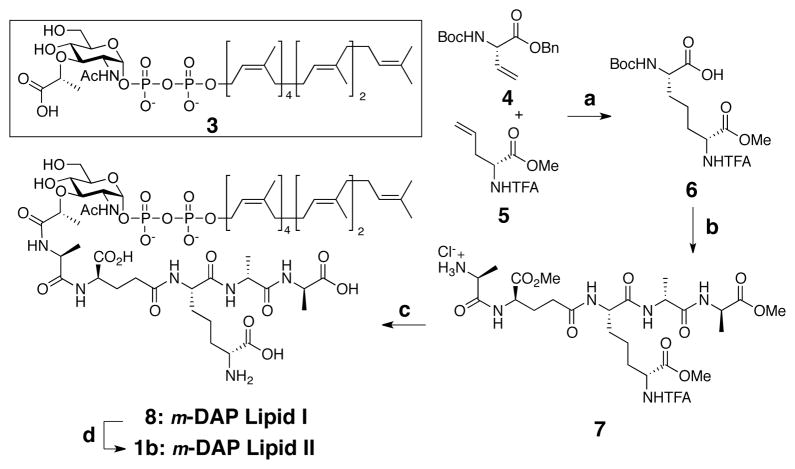Abstract
The bacterial cell wall precursor, Lipid II, has a highly conserved structure among different organisms except for differences in the amino acid sequence of the peptide side chain. Here, we report an efficient and flexible synthesis of the canonical Lipid II precursor required for the assembly of Gram-negative peptidoglycan (PG). We use a rapid LC/MS assay to analyze PG glycosyltransfer (PGT) and transpeptidase (TP) activities of Escherichia coli penicillin binding proteins PBP1A and PBP1B and show that the native m-DAP residue in the peptide side chain of Lipid II is required in order for TP-catalyzed peptide crosslinking to occur in vitro. Comparison of PG produced from synthetic canonical E. coli Lipid II with PG isolated from E. coli cells demonstrates that we can produce PG in vitro that resembles native structure. This work provides the tools necessary for reconstituting cell wall synthesis, an essential cellular process and major antibiotic target, in a purified system.
The most important antibiotics in clinical use target the bacterial cell wall (Figure 1a), a rigid polymer that is essential for survival under osmotic stress.1 The cell wall precursor, Lipid II (1, Figure 1b), is synthesized in the cytoplasm and then assembled into peptidoglycan (PG) outside the cytoplasmic membrane by high molecular weight, bifunctional penicillin binding proteins (PBPs) that contain PG glycosyl-transferase (PGT) and transpeptidase (TP) domains. The PGT and TP domains catalyze polymerization of Lipid II and cross-linking of the resulting glycan strands, respectively (Figure 1a). The study of high molecular weight PBPs is important because these enzymes are the lethal targets of the beta-lactam antibiotics;1 however, the required substrate, Lipid II, is difficult to obtain.2–4 Lipid II is a beta(1,4)-N-acetylglucosamine (GlcNAc)-N-acetylmuramic acid (MurNAc) disaccharide containing a diphospholipid at the reducing end. A pentapeptide is attached to the lactyl moiety of the MurNAc sugar. The structure of Lipid II is conserved in bacteria except for modifications at the third position of the peptide chain,5 which contains a nucleophilic amine that forms a crosslink with a D-Ala residue on another peptide side chain during the TP reaction (Figure 1a).
Figure 1.
Bacterial cell wall is assembled from the precursor Lipid II. (a) Schematic of an E. coli cell and the chemical structure of its cell wall, composed of alternating GlcNAc (blue) and Mur-NAc (green) residues with attached peptide side chains that can be crosslinked. Purified E. coli cell wall typically lacks terminal D-Ala residues (red). (b) Chemical structure of Gram-positive L-Lys Lipid II (1a) and Gram-negative m-DAP Lipid II (1b),8 which differ at the third residue of the peptide side chain. Because R varies depending on the organism, a flexible route to 1 is needed to study the PG synthesis of various organisms.
Synthesis of a Lipid II precursor containing L-Lys in the third position of the peptide side chain (1a, Figure 1b) has been reported previously2b,3,4 and has been useful for studying PG polymerization.3c–f, 6 Although TP-mediated hydrolysis of D-Ala-D-Ala peptide bonds was detected, no evidence for crosslinking was observed.3d,7a
In this paper we report the first chemical synthesis of the canonical Lipid II precursor for Gram-negative organisms (1b), which contains meso-diaminopimelic acid (m-DAP) as the third peptide residue. We show using a newly developed LC/MS assay capable of detecting both glycosyltransfer and transpeptidation products that 1b is converted to crosslinked PG by the two primary bifunctional PBPs in E. coli, PBP1A and PBP1B. We further show that PG produced in vitro from purified E. coli enzymes resembles the structure of native PG isolated from E. coli cells. These developments will enable mechanistic studies of PG transpeptidation and the production of crosslinked material for studies of other bacterial cell wall modifying enzymes.
We developed a flexible route to generate large quantities of m-DAP Lipid II (1b) that is amenable to installation of many different peptide side chains. Precursor 3, obtained as described,7,9 is devoid of protecting groups and can be elaborated to make Lipid II substrates from a variety of organisms by altering the stem peptide in the subsequent coupling step. Synthesis of the canonical Gram-negative pentapeptide moiety required access to an orthogonally protected m-DAP residue. We obtained a suitably masked m-DAP (6) by olefin cross metathesis of L-vinylglycine 4 and D-allylglycine 5 utilizing the Grubbs 2nd generation catalyst and subsequent hydrogenation.10 Pentapeptide 7 was formed from m-DAP by sequential condensation with NH2-D-Ala-D-Ala-OMe followed by Boc-L-Ala-γ-D-Glu(OH)-OMe. The precursor to Lipid II, Lipid I (8), was obtained through a DMTMM-promoted condensation7a of MurNAc heptaprenyl pyrophosphate (3) and pentapeptide 7 followed by protecting group hydrolysis under basic conditions. Lipid I was then converted to the desired m-DAP-containing PBP substrate, Lipid II (1b), through MurG-catalyzed glycosylation with UDP-GlcNAc.3a–b,11 Unlike chemical glycosylation methods, the use of MurG provides Lipid II directly from unprotected Lipid I, providing amounts sufficient for hundreds of enzymatic reactions.
Existing methods to analyze the reactions catalyzed by high molecular weight PBPs rely on the use of authentic standards and radiometry to identify fragments generated after post-reaction degradation.2c–d,12 We adapted the classical HPLC method for analysis of cell wall fragments,13 which relies on non-volatile salts as the mobile phase additive, so that the separation conditions are compatible with LC/MS. The modified method improved sensitivity and enabled direct product identification.14 We initially tested two substrates that varied only at the third peptide residue, L-Lys Lipid II (1a), which is the precursor for most Gram-positive PG, and m-DAP Lipid II (1b), which is the precursor for most Gram-negative PG. Each substrate was incubated with E. coli PBP1A, one of the organism’s two bifunctional PBPs.6k The reactions were then treated with mutanolysin, which cleaves MurNAc-GlcNAc bonds, to digest polymeric products, followed by sodium borohydride, which reduces the MurNAc termini in order to simplify the mixture by converging anomers (Figure 2a).
Figure 2.
The m-DAP residue in Lipid II is essential for trans-peptidase-catalyzed crosslinking. (a) Schematic of method for analyzing PG synthesis by PBPs.14 (b) LC/MS extracted chromatograms of PBP1A and L-Lys Lipid II (1a) reactions produce only A′, representing unmodified polymer, in the presence of the inhibitor penG (i), but both A′ and B′, representing hydrolyzed peptide side chain, without penG (ii). PBP1A and m-DAP-Lipid II (1b) reactions reveal fragment C in addition to fragments A and B, indicating the formation of crosslinked PG (iv); no crosslinks are formed in the presence of penG (iii). The PGT inhibitor moenomycin prevented formation of all fragment peaks (Figure S1). For chromatograms (i, ii): (M+2H)/2 ions corresponding to fragments A′ and B′ were extracted: A′: 485.2; B′: 449.7; masses corresponding to predicted crosslinked fragments were not observed. For chromatograms (iii, vi): (M+2H)/2 ions corresponding to fragments A–D were extracted: A: 507.2; B: 471.7; C: 968.9; D: 933.4.
LC/MS analysis of 1a reactions revealed exclusively disaccharide-pentapeptide fragment A′ in the presence of TP inhibitor penicillin G (penG, Figure 2b, trace i) and a small amount of disaccharide-tetrapeptide B′ due to TP-catalyzed hydrolysis in the absence of inhibitor (Figure 2b, trace ii). Reactions with 1b produced only A in the presence of penG (Figure 2b, trace iii); however, fragments A, B, and an additional fragment, C, arising from TP-catalyzed crosslinking, were observed without added TP inhibitor (Figure 2b, trace iv). Hence, although E. coli PBP1A polymerizes both L-Lys Lipid II (1a) and m-DAP Lipid II (1b), it can only crosslink glycan strands containing m-DAP. The fact that only m-DAP (Figure 1a, R = COOH) and not L-Lys (R = H) can act as a nucleophile in the cross-linking reaction explains in vivo data showing that while L-Lys can be incorporated into PG in E. coli, the ε-amine of Lys was never detected in crosslinks.15 This result also clarifies why crosslinks could not be detected previously when L-Lys Lipid II was incubated with E. coli PBPs in vitro,3d,7a as the TP domain is selective for its native substrate. Similar to PBP1A, E. coli PBP1B polymerizes both 1a and 1b, but only crosslinks the m-DAP glycan strands (See Supporting Information (SI), Figure S2). These results verify that the assay detects both glycosyltransfer and transpeptidation activities of bifunctional PBPs, and that the m-DAP residue in E. coli PG is necessary in the peptide side chain for crosslinking to occur in vitro.16
Using the LC/MS assay, we next compared the composition of synthetic PG to isolated bacterial cell wall. Purified E. coli cell wall lacks pentapeptide-containing PG fragments and it was proposed that this is due partially to the activity of the carboxypeptidase PBP5,17a–b which removes the terminal D-Ala residue from peptide side chains (Figure 3a).17 We compared PBP1A-generated cell wall treated with PBP5 (Figure 3b, trace i) to cell wall isolated from E. coli cultures using standard protocols13,18 (Figure 3b, trace ii). In both traces, we observed cell wall fragments B and D, representing the disaccharide tetrapeptide (tetra) and the hydrolyzed crosslinked product (tetra-tetra), respectively.
Figure 3.
The composition of PG produced in vitro resembles PG isolated from E. coli cells. (a) Schematic of experimental procedure for PG analysis shows that fragments A and C would result from degradation of PG synthesized in vitro, while B and D would result from prior hydrolysis of PG by E. coli PBP5,17d which liberates terminal D-Ala residues. (b) Treatment of PBP1A and 1b reactions with PBP5 produces hydrolysis fragments B and D (i) in proportions similar to those found in treated in vivo PG sample (ii). In vitro samples were prepared as before,14 except quenched PBP1A reactions were treated with PBP5 (0.8 μM) for 2 hr prior to analysis. See SI for details on cell wall isolation. (M+2H)/2 ions corresponding to fragments A–D were extracted from each chromatogram: A: 507.2; B: 471.7; C: 968.9; D: 933.4.
Unlike reactions that contained only PBP1A (Figure 2b), the in vitro products treated with PBP5 were tetrapeptide-containing fragments like the major products generated from isolated sacculi (Figure S3). Hence, using only a few purified components and the native E. coli substrate, it is possible to reconstitute PG that is similar in composition to in vivo samples.
In summary, we have synthesized the E. coli cell wall precursor m-DAP Lipid II and used it in an LC/MS assay designed to analyze cell wall composition. E. coli PBP1A and PBP1B are able to polymerize both L-Lys substrate 1a and m-DAP substrate 1b, but crosslink only PG containing the appropriate substituent in the third position of the peptide side chain (m-DAP). The third residue in the peptide side chain is important in the TP reaction because it contains the reactive amine that forms crosslinks. Since cell wall from different organisms are built from precursors with varying peptide side chains5 and PBPs are sensitive to the identity of the reactive residues, it is important to have an efficient, flexible route to Lipid II that is amenable to changes in the composition of the peptide. Hence, the synthesis we described can be applied to the study of cell wall construction in other organisms, and this in vitro system can be used to investigate the proteins involved in the synthesis of different bacterial cell wall structures. Reconstructing how enzymes build and break PG will provide a better understanding of the maintenance of a complex cellular structure and may provide new insight into how to target the essential bacterial cytoskeleton.
Supplementary Material
Scheme 1.
Synthesis of m-DAP Lipid II (1b)a
aReagents and conditions: (a) i. Grubbs 2nd Gen. catalyst, DCM, 12h, reflux (50%); ii. H2/Pd, MeOH, 1 h, RT (90%); (b) i. NH2-D-Ala-D-Ala-OMe, EDC, HOBt, DIEA, DCM, 2h, RT; ii. 4M HCl in dioxane, 15 min., RT; iii. Boc-L-Ala-γ-D-Glu(OH)-OMe, EDC, HOBt, DIEA, DCM, 2h, RT; iv. 4M HCl in dioxane, 15 min., RT (54%); (c) i. 3, DMTNMM, DIEPA, MeOH, RT, 2h; ii. NaOH, H2O, dioxane, 45 min., RT (48%); (d) UDP-GlcNAc, MurG, buffer, 1h, RT.
Acknowledgments
This research was supported by the National Institutes of Health (R01 GM066174; R01 GM76710; F32 GM103056 to M.D.L.) and NERCE (AI057159). J.M.M. was supported by the National Science Foundation (DGE-1144152). LC/MS data acquired on an Agilent 6520 Q-TOF spectrometer was supported by the Talpin Funds for Discovery Program (P.I.: S.W.). We thank Sunia Trauger (Small Molecule Mass Spectrometry Facility, Harvard) for HRMS assistance and the Bernhardt Lab (Harvard Medical School) for overexpression plasmids (see SI).
Footnotes
Supporting Information. Experimental procedures, synthesis of substrates and compound analysis, protein construct descriptions and purification protocols, PG purification and degradation protocols, LC/MS and LC/Q-TOF analysis of substrates and muropeptide fragments. This material is available free of charge via the Internet at http://pubs.acs.org.
References
- 1.(a) Tomasz A. Annu Rev Microbiol. 1979;33:113–137. doi: 10.1146/annurev.mi.33.100179.000553. [DOI] [PubMed] [Google Scholar]; (b) Walsh C. Antibiotics : actions, origins, resistance. ASM Press; Washington, D.C: 2003. [Google Scholar]; (c) Lovering AL, Safadi SS, Strynadka NC. Annu Rev Biochem. 2012;81:451–478. doi: 10.1146/annurev-biochem-061809-112742. [DOI] [PubMed] [Google Scholar]
- 2.Lipid II containing various peptide side chains can be accessed by treating isolated cell wall precursors with membrane preparations or MraY/lipid phosphate, see: Anderson JS, Matsuhashi M, Haskin MA, Strominger JL. Proc Natl Acad Sci USA. 1965;53:881–889. doi: 10.1073/pnas.53.4.881.Breukink E, van Heusden HE, Vollmerhaus PJ, Swiezewska E, Brunner L, Walker S, Heck AJR, De Kruijff B. J Biol Chem. 2003;278:19898–19903. doi: 10.1074/jbc.M301463200.Bertsche U, Breukink E, Kast T, Vollmer W. J Biol Chem. 2005;280:38096–38101. doi: 10.1074/jbc.M508646200.Born P, Breukink E, Vollmer W. J Biol Chem. 2006;281:26985–26993. doi: 10.1074/jbc.M604083200.El Ghachi M, Bouhss A, Barreteau H, Touzé T, Auger G, Blanot D, Mengin-Lecreulx D. J Biol Chem. 2006;281:22761–22772. doi: 10.1074/jbc.M602834200.Lloyd AJ, Gilbey AM, Blewett AM, De Pascale G, El Zoeiby A, Levesque RC, Catherwood AC, Tomasz A, Bugg TDH, Roper DI, Dowson CG. J Biol Chem. 2008;283:6402–6417. doi: 10.1074/jbc.M708105200.Patin D, Barreteau H, Auger G, Magnet S, Crouvoisier M, Bouhss A, Touzé T, Arthur M, Mengin-Lecreulx D, Blanot D. Biochimie. 2012;94:985–990. doi: 10.1016/j.biochi.2011.12.019.
- 3.L-Lys-containing Lipid II can be accessed by synthetic/semi-synthetic methods, see: Men H, Park P, Ge M, Walker S. J Am Chem Soc. 1998;120:2484–2485.Ha S, Chang E, Lo M, Men H, Park P, Ge M, Walker S. J Am Chem Soc. 1999;121:8415–8426.Ye X, Lo M, Brunner L, Walker D, Kahne D, Walker S. J Am Chem Soc. 2001;123:3155–3156. doi: 10.1021/ja010028q.Schwartz B, Markwalder JA, Wang Y. J Am Chem Soc. 2001;123:11638–11643. doi: 10.1021/ja0166848.VanNieuwenhze M, Mauldin S, Zia-Ebrahimi M, Winger B, Hornback W, Saha S, Aikins J, Blaszczak L. J Am Chem Soc. 2002;124:3656–3660. doi: 10.1021/ja017386d.Shih HW, Chang YF, Li WJ, Meng FC, Huang CY, Ma C, Cheng TJR, Wong CH, Cheng WC. Angew Chem Int Ed (English) 2012;51:10123–10126. doi: 10.1002/anie.201204038.
- 4.Liu C-Y, Guo C-W, Chang Y-F, Wang J-T, Shih H-W, Hsu Y-F, Chen C-W, Chen S-K, Wang Y-C, Cheng T-JR, Ma C, Wong C-H, Fang J-M, Cheng W-C. Org Lett. 2010;12:1608–1611. doi: 10.1021/ol100338v. [DOI] [PubMed] [Google Scholar]
- 5.Bouhss A, Trunkfield AE, Bugg TDH, Mengin-Lecreulx D. FEMS Microbiol Rev. 2008;32:208–233. doi: 10.1111/j.1574-6976.2007.00089.x. [DOI] [PubMed] [Google Scholar]
- 6.(a) Chen L, Walker D, Sun B, Hu Y, Walker S, Kahne D. Proc Natl Acad Sci USA. 2003;100:5658–5663. doi: 10.1073/pnas.0931492100. [DOI] [PMC free article] [PubMed] [Google Scholar]; (b) Chen L, Yuan Y, Helm JS, Hu Y, Rew Y, Shin D, Boger DL, Walker S. J Am Chem Soc. 2004;126:7462–7463. doi: 10.1021/ja047879t. [DOI] [PubMed] [Google Scholar]; (c) Barrett DS, Chen L, Litterman NK, Walker S. Biochemistry. 2004;43:12375–12381. doi: 10.1021/bi049142m. [DOI] [PubMed] [Google Scholar]; (d) Barrett D, Leimkuhler C, Chen L, Walker D, Kahne D, Walker S. J Bacteriol. 2005;187:2215–2217. doi: 10.1128/JB.187.6.2215-2217.2005. [DOI] [PMC free article] [PubMed] [Google Scholar]; (e) Barrett D, Wang TS, Yuan Y, Zhang Y, Kahne D, Walker S. J Biol Chem. 2007;282:31964–31971. doi: 10.1074/jbc.M705440200. [DOI] [PMC free article] [PubMed] [Google Scholar]; (f) Yuan Y, Barrett D, Zhang Y, Kahne D, Sliz P, Walker S. Proc Natl Acad Sci USA. 2007;104:5348–5353. doi: 10.1073/pnas.0701160104. [DOI] [PMC free article] [PubMed] [Google Scholar]; (g) Fang X, Tiyanont K, Zhang Y, Wanner J, Boger D, Walker S. Mol BioSyst. 2006;2:69–76. doi: 10.1039/b515328j. [DOI] [PubMed] [Google Scholar]; (h) Perlstein DL, Zhang Y, Wang TS, Kahne DE, Walker S. J Am Chem Soc. 2007;129:12674–12675. doi: 10.1021/ja075965y. [DOI] [PMC free article] [PubMed] [Google Scholar]; (i) Wang TS, Manning S, Walker S, Kahne D. J Am Chem Soc. 2008;130:14068–14069. doi: 10.1021/ja806016y. [DOI] [PMC free article] [PubMed] [Google Scholar]; (j) Perlstein D, Wang TS, Doud E, Kahne D, Walker S. J Am Chem Soc. 2010;132:48–49. doi: 10.1021/ja909325m. [DOI] [PMC free article] [PubMed] [Google Scholar]; (k) Paradis-Bleau C, Markovski M, Uehara T, Lupoli TJ, Walker S, Kahne DE, Bernhardt TG. Cell. 2010;143:1110–1120. doi: 10.1016/j.cell.2010.11.037. [DOI] [PMC free article] [PubMed] [Google Scholar]
- 7.(a) Lupoli TJ, Tsukamoto H, Doud EH, Wang TS, Walker S, Kahne D. J Am Chem Soc. 2011;133:10748–10751. doi: 10.1021/ja2040656. [DOI] [PMC free article] [PubMed] [Google Scholar]; (b) Tsukamoto H, Kahne D. Bioorg Med Chem Lett. 2011;21:5050–5053. doi: 10.1016/j.bmcl.2011.04.061. [DOI] [PMC free article] [PubMed] [Google Scholar]; (c) Weerapana E, Glover KJ, Chen MM, Imperiali B. J Am Chem Soc. 2005;127:13766–13767. doi: 10.1021/ja054265v. [DOI] [PMC free article] [PubMed] [Google Scholar]
- 8.A heptaprenyl lipid chain was used rather than the most commonly found natural lipid (undecaprenyl) because the former does not aggregate as extensively and thus is a better substrate for biochemical studies (see ref 3c).
- 9.(a) Gampe CM, Tsukamoto H, Wang TS, Walker S, Kahne D. Tetrahedron. 2011;67:9771–9778. doi: 10.1016/j.tet.2011.09.114. [DOI] [PMC free article] [PubMed] [Google Scholar]; (b) Hesek D, Lee M, Zajíček J, Fisher JF, Mobashery S. J Am Chem Soc. 2012;134:13881–13888. doi: 10.1021/ja306184m. [DOI] [PMC free article] [PubMed] [Google Scholar]
- 10.Chowdhury AR, Boons G-J. Tetrahedron Lett. 2005;46:1675–1678. [Google Scholar]
- 11.Ha S, Walker D, Shi Y, Walker S. Protein Sci. 2000;9:1045–1052. doi: 10.1110/ps.9.6.1045. [DOI] [PMC free article] [PubMed] [Google Scholar]
- 12.(a) Muller P, Ewers C, Bertsche U, Anstett M, Kallis T, Breukink E, Fraipont C, Terrak M, Nguyen-Disteche M, Vollmer W. J Biol Chem. 2007;282:36394–36402. doi: 10.1074/jbc.M706390200. [DOI] [PubMed] [Google Scholar]; (b) Typas A, Banzhaf M, van den Berg van Saparoea B, Verheul J, Biboy J, Nichols RJ, Zietek M, Beilharz K, Kannenberg K, von Rechenberg M, Breukink E, den Blaauwen T, Gross CA, Vollmer W. Cell. 2010;143:1097–1109. doi: 10.1016/j.cell.2010.11.038. [DOI] [PMC free article] [PubMed] [Google Scholar]
- 13.Glauner B, Höltje JV, Schwarz U. J Biol Chem. 1988;263:10088–10095. [PubMed] [Google Scholar]
- 14.Lipid II (1a or 1b, 40 μM) was incubated with E. coli PBP1A or PBP1B (400 nM) in 50 mM HEPES (4-(2-hydroxyethyl)-1-piperazine-ethanesulfonic acid), 10 mM CaCl2, 20% DMSO, pH = 7.5 (10 μL total volume) for 20 min at 25 °C in the presence or absence of penicillin G (1 kU/mL). The reaction was quenched at 95 °C for 5 min and then treated with mutanolysin (1U for 1.5 h and then 1U for an additional 1.5 h at 37 °C) and sodium borohydride (10 μL, 10 mg/mL, 30 min). Phosphoric acid (20% v/v, 1.2 μL) was added to adjust pH to ~4. The mixture was lyophilized, redissolved in 10 μL water and subjected to LC/MS analysis (ESI-MS, positive mode, Waters SymmetryShield RP18 column, 5 μm, 3.9 x 150 mm). Fragments were separated with water (0.1% formic acid) for 5 min followed by a gradient of 0 to 20% acetonirile (0.1% formic acid)/water (0.1% formic acid) over 40 min at 0.5 mL/min. Molecular ions corresponding to expected disaccharide fragments were extracted from the chromatogram. See SI for more details.
- 15.(a) Mengin-Lecreulx D, Falla T, Blanot D, van Heijenoort J, Adams DJ, Chopra I. J Bacteriol. 1999;181:5909–5914. doi: 10.1128/jb.181.19.5909-5914.1999. [DOI] [PMC free article] [PubMed] [Google Scholar]; (b) Mengin-Lecreulx D, Michaud C, Richaud C, Blanot D, van Heijenoort J. J Bacteriol. 1988;170:2031–2039. doi: 10.1128/jb.170.5.2031-2039.1988. [DOI] [PMC free article] [PubMed] [Google Scholar]
- 16.Previous studies have shown that m-DAP Lipid II forms crosslinked PG, see references 2c–d and 11.
- 17.(a) Kraus W, Holtje JV. J Bacteriol. 1987;169:3099–3103. doi: 10.1128/jb.169.7.3099-3103.1987. [DOI] [PMC free article] [PubMed] [Google Scholar]; (b) Li SY, Holtje JV, Young KD. Anal Biochem. 2004;326:1–12. doi: 10.1016/j.ab.2003.11.007. [DOI] [PMC free article] [PubMed] [Google Scholar]; (c) Nicholas RA, Strominger JL. J Biol Chem. 1988;263:2034–2040. [PubMed] [Google Scholar]; (d) Zhang W, Shi Q, Meroueh SO, Vakulenko SB, Mobashery S. Biochemistry. 2007;46:10113–10121. doi: 10.1021/bi700777x. [DOI] [PubMed] [Google Scholar]
- 18.Uehara T, Dinh T, Bernhardt TG. J Bact. 2009;191:5094–5107. doi: 10.1128/JB.00505-09. [DOI] [PMC free article] [PubMed] [Google Scholar]
Associated Data
This section collects any data citations, data availability statements, or supplementary materials included in this article.






